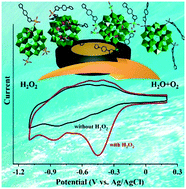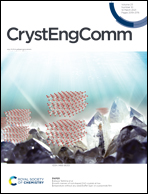Preyssler-type polyoxometalate-based crystalline materials for the electrochemical detection of H2O2†
Abstract
Exploring an efficient non-enzymetic electrochemical sensor towards the detection of H2O2 is of great significance for the practical health monitoring and environmental analysis. In this study, four Preyssler-type polyoxometalate-based organic–inorganic hybrid materials were synthesized as non-enzymatic H2O2 electrochemical sensors having the formulae (H2bimb)6H4[(Mn(H2O)3)2(μ-bimb)(Mn(H2O)4(Mn(H2O)5)0.75(Mn(H2O)4)0.25(Na(H2O)P5W30O110))2]·30.5H2O (1), (H2bimb)3H4[(Co(H2O)4)2(μ-bimb)(Na(H2O)P5W30O110)]·10H2O (2), {[(Cu(Hbimb)(H2O)(μ-bimb)Cu(Hbimb)(H2O))(Cu(H2O)2(μ-bimb)Cu(H2O)2)((Cu(H2O)2)0.5(μ-bimb)(Cu(H2O)3)0.5)H2(Na(H2O)P5W30O110)]·12H2O}n (3) and (H2bimb)2H[((Zn(Hbimb)(H2O)2)0.5)2(Zn(Hbimb)(H2O)4)2(Na(H2O)P5W30O110)]·8H2O (4) (bimb = 1,4-bis(1H-imidazol-1-yl)benzene). In the compounds 1–4, Preyssler {P5W30} clusters show abundant coordination modes, and support the transition metal–organic fragments to give fascinating diverse networks. When used as electrochemical sensors for H2O2 detection, compounds 1–4 exhibited good electrocatalytic activities with high sensitivity and low detection limit. Among them, compound 2 showed the lowest limit of detection of 0.13 mM with a high sensitivity of 4.35 μA mM−1 and fast response time of 1 s. Moreover, compound 2 displayed excellent electrochemical operational stability and anti-interference capacity. This study provides a good choice for the development of promising electrochemical non-enzymatic H2O2 sensors by employing Preyssler {P5W30}-based materials.

- This article is part of the themed collection: Coordination Networks


 Please wait while we load your content...
Please wait while we load your content...